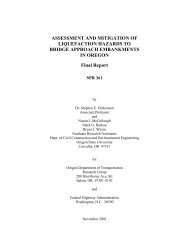Oregon Balance of State HIV/AIDS Housing & Services Systems ...
Oregon Balance of State HIV/AIDS Housing & Services Systems ...
Oregon Balance of State HIV/AIDS Housing & Services Systems ...
Create successful ePaper yourself
Turn your PDF publications into a flip-book with our unique Google optimized e-Paper software.
<strong>Oregon</strong> <strong>HIV</strong>/<strong>AIDS</strong> <strong>Housing</strong> and <strong>Services</strong> <strong>Systems</strong> Integration Plan 29<br />
There are also occasional opportunities across the balance <strong>of</strong> state for housing providers to connect<br />
and share information on housing needs and programs. Each April, <strong>Oregon</strong> <strong>Housing</strong> and<br />
Community <strong>Services</strong> (OHCS) hosts the <strong>Oregon</strong> <strong>Housing</strong> Conference, which includes presentations<br />
from housing agencies across the state. Another example <strong>of</strong> a regional housing forum was the<br />
February 2006 Southern <strong>Oregon</strong> Workforce <strong>Housing</strong> Summit, which included representatives from<br />
Curry, Jackson, and Josephine Counties. 65<br />
Homeless <strong>Services</strong> and Prevention<br />
The impacts <strong>of</strong> homelessness can be particularly devastating for people living with <strong>HIV</strong>/<strong>AIDS</strong>, for<br />
whom housing stability is directly linked with access to treatment and health outcomes. Despite the<br />
need for homeless services and prevention for people living with <strong>HIV</strong>/<strong>AIDS</strong>, stakeholders reported<br />
limited involvement by <strong>HIV</strong>/<strong>AIDS</strong> housing and services providers in key homeless services<br />
planning processes. Agency-level links may exist (such as referral <strong>of</strong> clients to faith- or other<br />
community-based homeless shelters, as a bridge to permanent housing and other services), but<br />
understanding and accessing homelessness system planning is critical to meeting joint challenges.<br />
The following sections describe the two key planning processes: the Continuum <strong>of</strong> Care system, and<br />
state and local 10-Year Plans to End Homelessness.<br />
Continuum <strong>of</strong> Care Process<br />
The Continuum <strong>of</strong> Care system is a regional planning process that includes a combined annual<br />
application for HUD’s primary homeless assistance programs, including the Supportive <strong>Housing</strong><br />
Program (SHP), Single Room Occupancy (SRO) Program, and Shelter Plus Care. Like the<br />
Consolidated Plan process, the Continuum <strong>of</strong> Care provides opportunities for regional systems to<br />
set priorities for federal funding.<br />
There are five Continua <strong>of</strong> Care that cover the balance <strong>of</strong> state. Each Continuum is allocated an<br />
initial pro rata need funding amount based on the relative homeless assistance need determined by<br />
HUD. Communities can receive funding above this level through successful applications for<br />
“bonus” projects that must provide permanent housing for chronically homeless individuals.<br />
65 Southern <strong>Oregon</strong> Workforce <strong>Housing</strong> Summit. Available online: http://www.ashland.or.us/Files/wfh_book_final.pdf (Accessed:<br />
January 15, 2008).

















